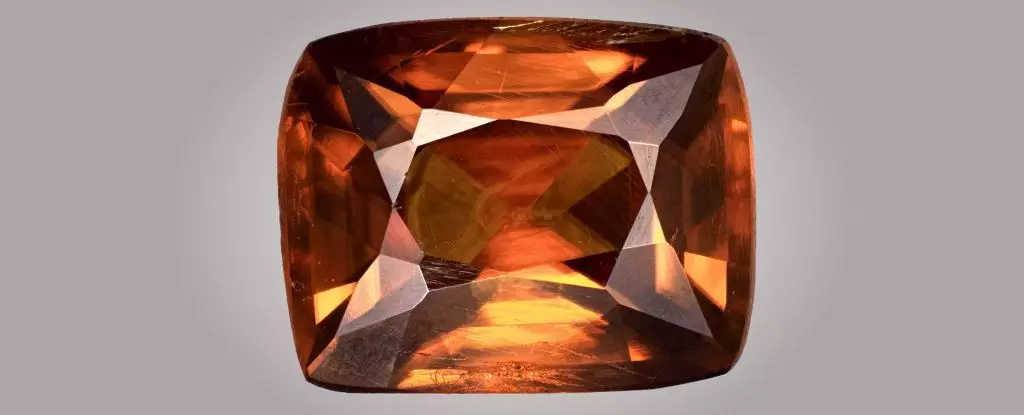In a world filled with gemstones, each with its own unique charm and allure, the discovery of a singular mineral captures the imagination of gem enthusiasts and geologists alike. Kyawthuite is a remarkable specimen that defies ordinary classification, not only due to its unprecedented rarity but also due to its stunning characteristics and mysterious origins. It stands alone in the mineral kingdom as a testament to the incredible complexity and diversity that nature can offer.
Kyawthuite’s journey began relatively unassumingly in 2010 when gemologist Kyaw Thu stumbled upon the mineral at a marketplace in Chaung-gyi, Myanmar. Initially mistaken for a more common mineral, scheelite, this tawny-hued speck caught Thu’s eye. However, it was after he faceted the stone that he recognized its uniqueness. The careful work of gem cutting often reveals the hidden beauty of a gem, and in this case, it unveiled a mystery. Upon further examination, Thu found that the mineral did not correlate with any known species, prompting him to consult the experts at the Gemological Institute of America (GIA) Laboratory in Bangkok.
The GIA’s findings revealed that kyawthuite bore resemblance to a specific synthetic compound, bismuth antimonate, yet its exact structure—Bi3+Sb5+O4—had never been documented in nature before. This extraordinary revelation solidified kyawthuite’s status as a world-first and prompted a cascade of interest from scholars, enthusiasts, and museum curators alike.
The aesthetically pleasing saturated orange hue with subtle red overtones gives kyawthuite its striking visual appeal, making it comparable to both amber and topaz at first glance. Such analogies, however, fall short when one examines the chemical and physical uniqueness of this gem. The gem produces a white streak when dragged across a rough surface, revealing its composition to the trained eye. Notably, kyawthuite is characterized by tubular inclusions known as en echelon veins—evidence of shear stress during its natural formation, further contributing to its intrigue.
Geologists propose that kyawthuite is igneous in origin, likely sourced from the common volcanic rock known as pegmatite. This hypothesis aligns with the gem’s unique inclusion of various trace minerals, including titanium, niobium, tungsten, and uranium. Pegmatite, often likened to a “fruitcake” of varying mineral compositions, provides a fertile ground for the discovery of large crystal formations. This geological backdrop enhances cemented kyawthuite’s standing as a unique marvel of the natural world.
When discussing rarity in gemstones, kyawthuite takes the crown; only one specimen has ever been found, making it a geological and collector’s dream. The rarity speaks volumes not only to the natural processes that led to its formation but also to the socio-economic factors surrounding gem acquisition. While other rare stones like painite can fetch significant sums—between $50,000 and $60,000 per carat—kyawthuite’s value is so uncharted that it has been deemed “priceless.” This enigmatic value proposition casts kyawthuite as a unique case study in mineral economics and conservation.
It is essential to observe how the mining and trading of gemstones affect environmental and social systems. The discovery of kyawthuite in Myanmar brings into focus the importance of ethical gem sourcing, emphasizing responsible practices that honor both the natural world and the communities involved in mining.
Currently housed at the National History Museum of Los Angeles County, kyawthuite exemplifies the union between scientific exploration and public education. Museums serve as custodians of our planet’s geological heritage, providing a platform for individuals to engage with the wonders of the natural world. As the only known specimen, kyawthuite holds within it a wealth of stories waiting to be uncovered, and its preservation is imperative.
As scientists continue to study this remarkable mineral, there lies the potential for new discoveries that could redefine our understanding of mineral formation. Researchers are encouraged to explore not only the physical properties of kyawthuite but also to delve into the consequential environmental contexts from which it emerged.
Kyawthuite is more than just a mineral; it is a symbol of nature’s profound complexities and the mysteries that remain to be unraveled. Its existence inspires appreciation for the rare and unique components of our planet’s geological tapestry. As curiosity drives research and conservation efforts, strides made with kyawthuite will resonate across the scientific community and beyond, reminding us of the wonders that lie hidden within the earth and the stories they hold.

Leave a Reply